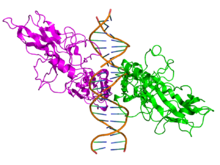NF-kB
| NFKB1 | |
|---|---|

|
|
| Identifiers | |
| Symbol | NFKB1 |
| Entrez | 4790 |
| HUGO | 7794 |
| OMIM | 164011 |
| RefSeq | NM_003998 |
| UniProt | P19838 |
| Other data | |
| Locus | Chr. 4 q24 |
| RELA | |
|---|---|

|
|
| Identifiers | |
| Symbol | RELA |
| Entrez | 5970 |
| HUGO | 9955 |
| OMIM | 164014 |
| RefSeq | NM_021975 |
| UniProt | Q04206 |
| Other data | |
| Locus | Chr. 11 q13 |
| NFKB2 | |
|---|---|
| Identifiers | |
| Symbol | NFKB2 |
| Entrez | 4791 |
| HUGO | 7795 |
| OMIM | 164012 |
| RefSeq | NM_002502 |
| UniProt | Q00653 |
| Other data | |
| Locus | Chr. 10 q24 |
| RELB | |
|---|---|
| Identifiers | |
| Symbol | RELB |
| Entrez | 5971 |
| HUGO | 9956 |
| OMIM | 604758 |
| RefSeq | NM_006509 |
| UniProt | Q01201 |
| Other data | |
| Locus | Chr. 19 q13.2-19q13 |
| REL | |
|---|---|
| Identifiers | |
| Symbol | REL |
| Entrez | 5966 |
| HUGO | 9954 |
| OMIM | 164910 |
| RefSeq | NM_002908 |
| UniProt | Q04864 |
| Other data | |
| Locus | Chr. 2 p13-p12 |
NF-κB (nuclear factor kappa-light-chain-enhancer of activated B cells) is a protein complex that controls transcription of DNA, cytokine production and cell survival. NF-κB is found in almost all animal cell types and is involved in cellular responses to stimuli such as stress, cytokines, free radicals, heavy metals, ultraviolet irradiation, oxidized LDL, and bacterial or viral antigens. NF-κB plays a key role in regulating the immune response to infection (κ light chains are critical components of immunoglobulins). Incorrect regulation of NF-κB has been linked to cancer, inflammatory and autoimmune diseases, septic shock, viral infection, and improper immune development. NF-κB has also been implicated in processes of synaptic plasticity and memory.
NF-κB was discovered by Dr. Ranjan Sen in the lab of Nobel Prize laureate David Baltimore via its interaction with an 11-base pair sequence in the immunoglobulin light-chain enhancer in B cells.
All proteins of the NF-κB family share a Rel homology domain in their N-terminus. A subfamily of NF-κB proteins, including RelA, RelB, and c-Rel, have a transactivation domain in their C-termini. In contrast, the NF-κB1 and NF-κB2 proteins are synthesized as large precursors, p105, and p100, which undergo processing to generate the mature NF-κB subunits, p50 and p52, respectively. The processing of p105 and p100 is mediated by the ubiquitin/proteasome pathway and involves selective degradation of their C-terminal region containing ankyrin repeats. Whereas the generation of p52 from p100 is a tightly regulated process, p50 is produced from constitutive processing of p105. The p50 and p52 proteins have no intrinsic ability to activate transcription and thus have been proposed to act as transcriptional repressors when binding κB elements as homodimers. Indeed, this confounds the interpretation of p105-knockout studies, where the genetic manipulation is removing an IκB (full-length p105) and a likely repressor (p50 homodimers) in addition to a transcriptional activator (the RelA-p50 heterodimer).
...
Wikipedia
